Synthesis and Characterization of Electrical and Thermal Conductive Vinyltriethoxysilane Functionalized Graphene Oxide/Poly (Methyl Methacrylate) Nanocomposite Films
Abstract
:1. Introduction
2. Experimental Section
2.1. Materials and Methods
2.2. Synthesis of VGO
2.3. Synthesis of GO and VGO/PMMA Nanocomposite Films
2.4. Characterization
3. Results and Discussion
3.1. Characterization of VGO
3.2. Characterization of PMMA/VGO Nanocomposite Films
4. Conclusions
Author Contributions
Funding
Institutional Review Board Statement
Informed Consent Statement
Data Availability Statement
Conflicts of Interest
References
- El-Gamal, S.; Elsayed, M. Synthesis, structural, thermal, mechanical, and nano-scale free volume properties of novel PbO/PVC/PMMA nanocomposites. Polymer 2020, 33, 122911. [Google Scholar] [CrossRef]
- Bisen, R.; Tripathi, J.; Sharma, A.; Khare, A.; Kumar, Y.; Tripathi, S. Optical behaviour of coumarin dye in PVA and PMMA film matrices. Vacuum 2018, 152, 65–69. [Google Scholar] [CrossRef]
- Abutalib, M.M.; Rajeh, A. Influence of MWCNTs/Li-doped TiO2 nanoparticles on the structural, thermal, electrical and mechanical properties of poly (ethylene oxide)/poly (methylmethacrylate) composite. J. Organomet. Chem. 2020, 918, 121309. [Google Scholar] [CrossRef]
- Jamalpour, S.; Ghahramani, M.; Ghaffarian, S.R.; Javanbakht, M. The effect of poly (hydroxyl ethyl methacrylate) on the performance of PVDF/P (MMA-co-HEMA) hybrid gel polymer electrolytes for lithium ion battery application. Polymer 2020, 195, 122427. [Google Scholar] [CrossRef]
- Yihun, F.A.; Ifuk, S.; Saimoto, H.; Izawa, H.; Morimoto, M. Highly transparent and flexible surface modified chitin nanofibers reinforced poly (methyl methacrylate) nanocomposites: Mechanical, thermal and optical studies. Polymer 2020, 197, 122497. [Google Scholar] [CrossRef]
- Dreyer, D.R.; Park, S.; Bielawski, C.W.; Ruoff, R.S. The chemistry of graphene oxide. Chem. Soc. Rev. 2010, 39, 228–240. [Google Scholar] [CrossRef] [PubMed]
- Cote, L.J.; Kim, F.; Huang, J. Langmuir-Blodgett assembly of graphite oxide single layers. J. Am. Chem. Soc. 2009, 131, 1043–1049. [Google Scholar] [CrossRef]
- Salavagione, H.J.; Martinez, G.; Ellis, G. Recent advances in the covalent modification of graphene with polymers. Macromol. Rapid Commun. 2011, 32, 1771–1779. [Google Scholar] [CrossRef]
- Liao, W.H.; Yang, S.Y.; Wang, J.Y.; Tien, H.W.; Hsiao, S.T.; Wang, Y.S.; Li, S.M.; Wu, Y.F.; Ma, C.C. Effect of molecular chain length on the mechanical and thermal properties of amine-functionalized graphene oxide/polyimide composite films prepared by in situ polymerization. ACS Appl. Mater. Interfaces 2013, 5, 869–877. [Google Scholar] [CrossRef]
- Vlachopoulou, M.-E.; Tserepi, A.; Pavli, P.; Argitis, P.; Sanopoulou, M.; Misiakos, K. A low temperature surface modification assisted method for bonding plastic substrates. J. Micromech. Microeng. 2009, 19, 015007–015013. [Google Scholar] [CrossRef]
- Riau, A.K.; Mondal, D.; Yam, G.H.F.; Setiawan, M.; Liedberg, B.; Venkatraman, S.S.; Mehta, J.S. Surface modification of PMMA to improve adhesion to corneal substitutes in a synthetic core-skirt keratoprosthesis. ACS Appl. Mater. Interfaces 2015, 7, 21690–21702. [Google Scholar] [CrossRef] [PubMed]
- Yuen, S.-M.; Ma, C.-C.M.; Chiang, C.-L.; Chang, J.-A.; Huang, S.-W.; Chen, S.-C.; Chuang, C.-Y.; Yang, C.-C.; Wei, M.-H. Silane-modified MWCNT/PMMA composites—Preparation, electrical resistivity, thermal conductivity and thermal stability. Compos. Part A 2007, 38, 2527–2535. [Google Scholar] [CrossRef]
- Ma, W.-S.; Li, J.; Zhao, X.S. Improving the thermal and mechanical properties of silicone polymer by incorporating functionalized graphene oxide. J. Mater. Sci. 2013, 48, 5287–5294. [Google Scholar] [CrossRef]
- Yang, H.; Li, F.; Shan, C.; Han, D.; Zhang, Q.; Niu, L. Covalently functionalization of chemically converted graphene sheets via silane and its reinforcement. J. Mater. Chem. 2009, 19, 4632–4638. [Google Scholar] [CrossRef]
- Zarrin, H.; Higgins, G.; Jun, Y.; Chen, Z. Functionalized graphene oxide nanocomposite membrane for low humidity and high temperature proton exchange membrane fuel cells. J. Phys. Chem. C 2011, 115, 20774–20781. [Google Scholar] [CrossRef]
- Ma, W.S.; Li, J.; Deng, B.J.; Zhao, X.S. Preparation and characterization of long chain alkyl silane functionalized graphene film. J. Mater. Sci. 2013, 48, 151–161. [Google Scholar] [CrossRef]
- Liang, J.; Huang, Y.; Zhang, Y. Molecular level dispersion of graphene into poly (vinyl alcohol) and effective reinforcement of their nanocomposite. Adv. Funct. Mater. 2009, 19, 2297–2302. [Google Scholar] [CrossRef]
- Wang, Y.; Shi, Z.; Fang, J.; Xu, H.; Yin, J. Graphene oxide/polybenzimidazole composites fabricated by a solvent exchange method. Carbon 2011, 49, 1199–1207. [Google Scholar] [CrossRef]
- Alagar, M.; Majeed, S.M.A.; Selvaganapathi, V. Studies on thermal, thermal ageing and morphological characteristics of EPDM-g-VTES/LLDPE. Eur. Polym. J. 2006, 42, 336–347. [Google Scholar] [CrossRef]
- Zhang, Q.G.; Liu, Q.L.; Meng, X.J.; Broadwell, I. Structure and pervaporation performance of novel quaternized poly (vinyl alcohol/ɣ aminopropyltriethoxysilane hybrid membranes. J. Appl. Polym. Sci. 2010, 118, 1121–1126. [Google Scholar]
- Zhang, Q.G.; Liu, Q.L.; Zhu, A.M.; Xiong, X. Characterization and permeation performance of novel organic-inorganic hybrid membranes of poly (vinyl alcohol)/1,2-Bis (triethoxysilyl) ethane. J. Phys. Chem. B 2008, 112, 16559–16565. [Google Scholar] [CrossRef] [PubMed]
- Wang, J.; Wang, X.; Xu, C.; Zhang, M.; Shang, X. Preparation of graphene/poly (vinyl alcohol) nanocomposites with enhanced mechanical properties and water resistance. Polym. Int. 2011, 60, 816–822. [Google Scholar] [CrossRef]
- Yuen, S.M.; Ma, C.-C.M.; Wu, H.-H.; Kuan, H.-C.; Chen, W.-J.; Liao, S.-H.; Hsu, C.-W.; Wu, H.-L. Preparation and thermal, electrical, and morphological properties of multiwalled carbon nanotube and epoxy composites. J. Appl. Polym. Sci. 2007, 103, 1272–1278. [Google Scholar] [CrossRef]

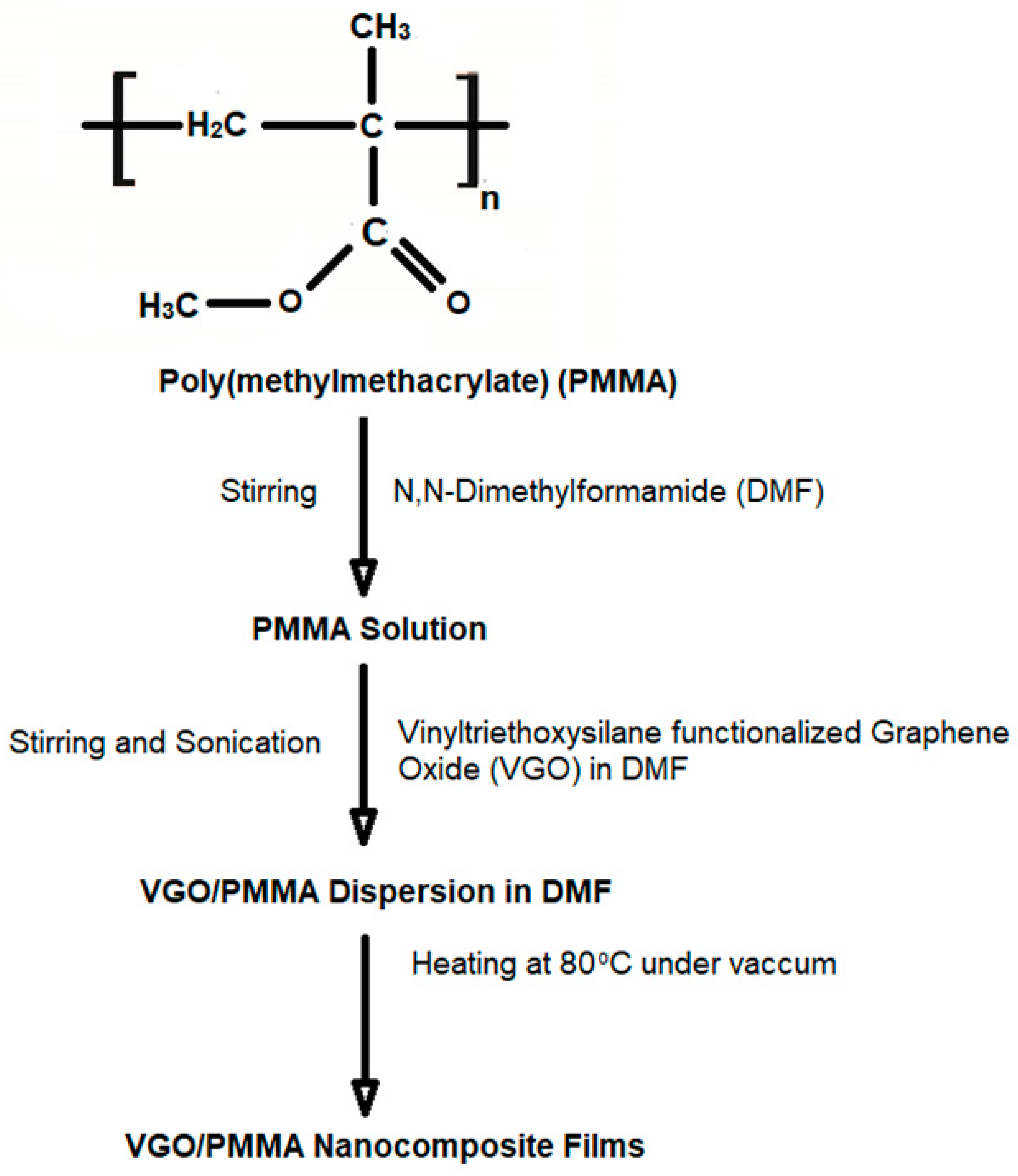


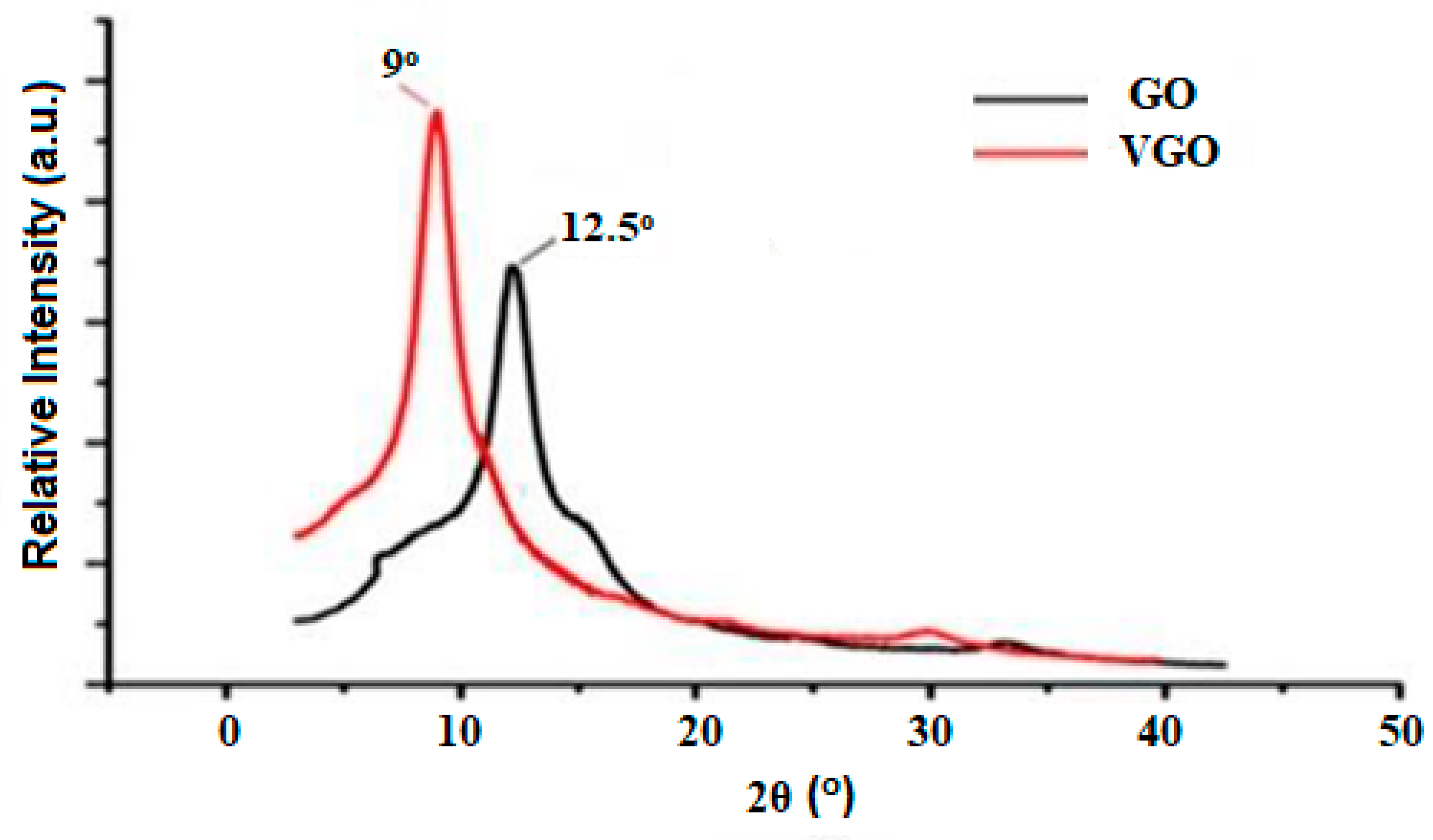
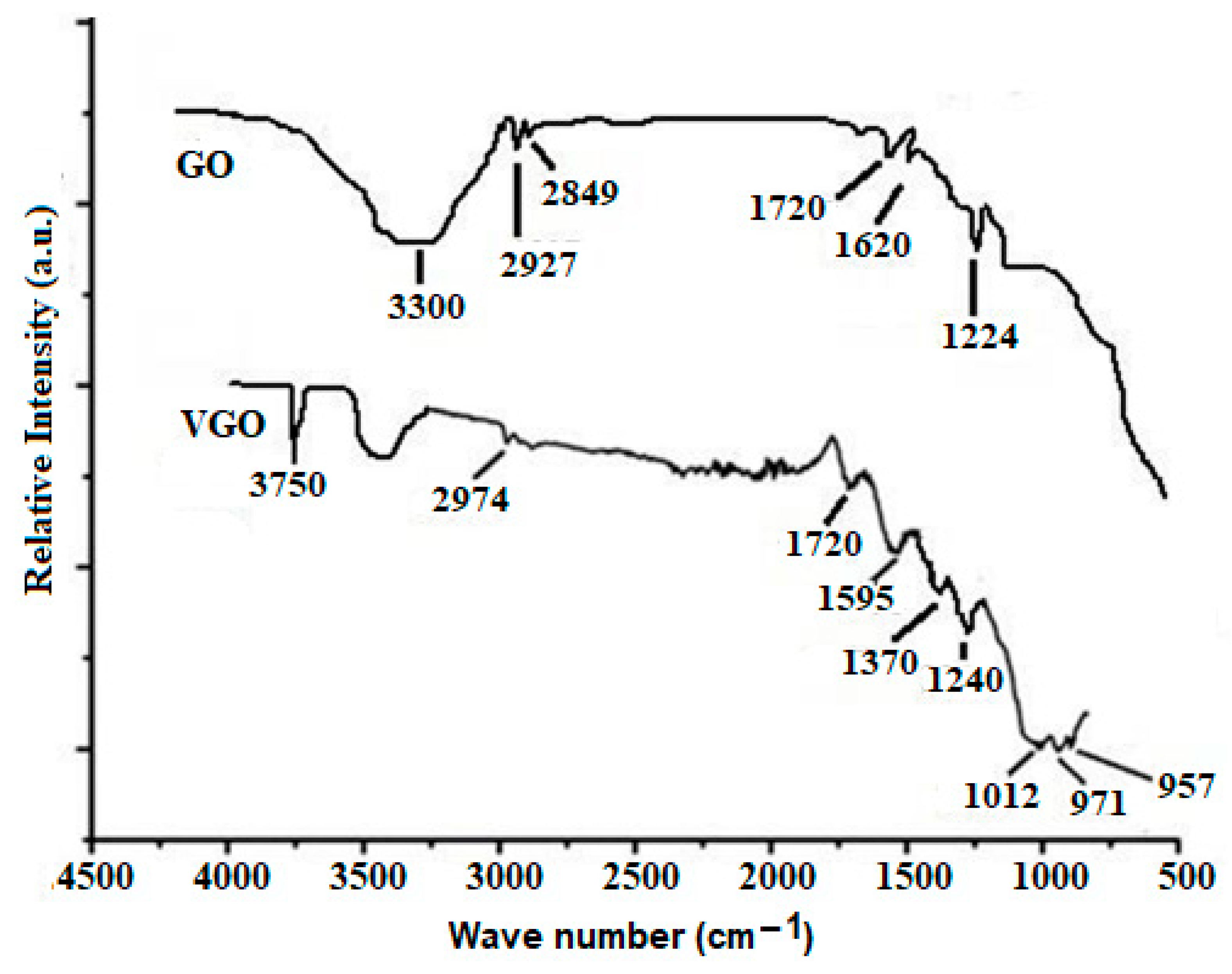


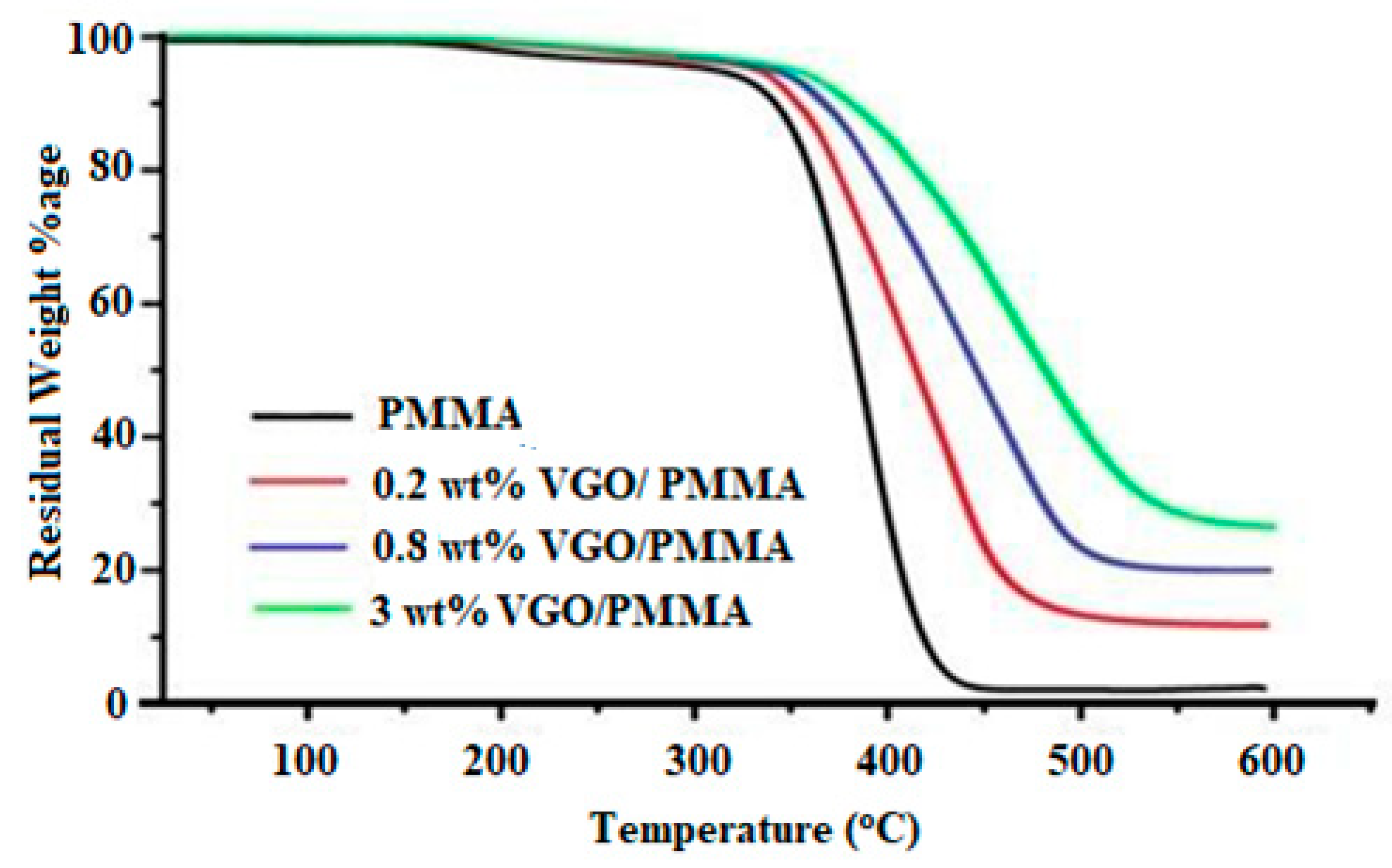


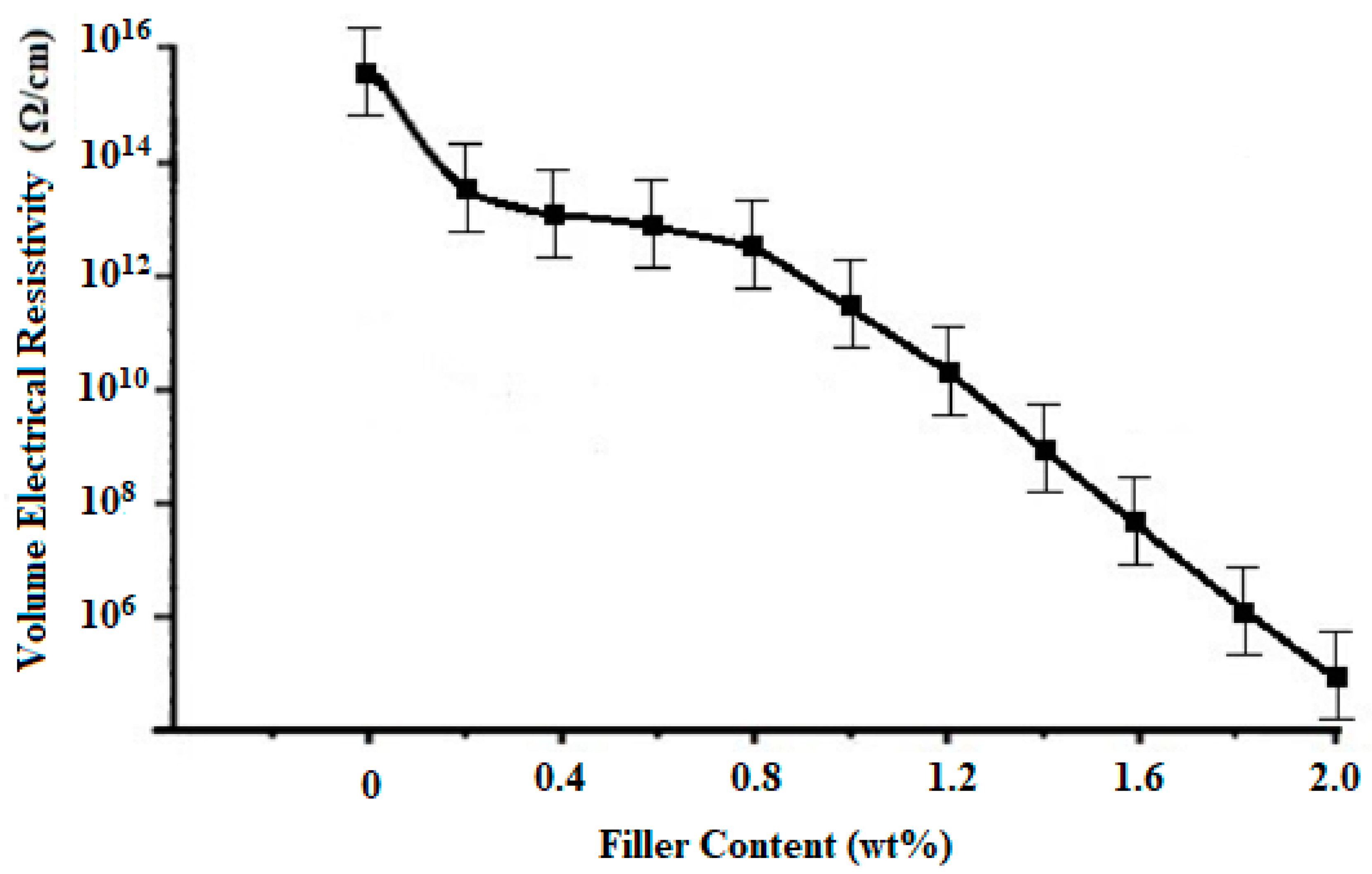
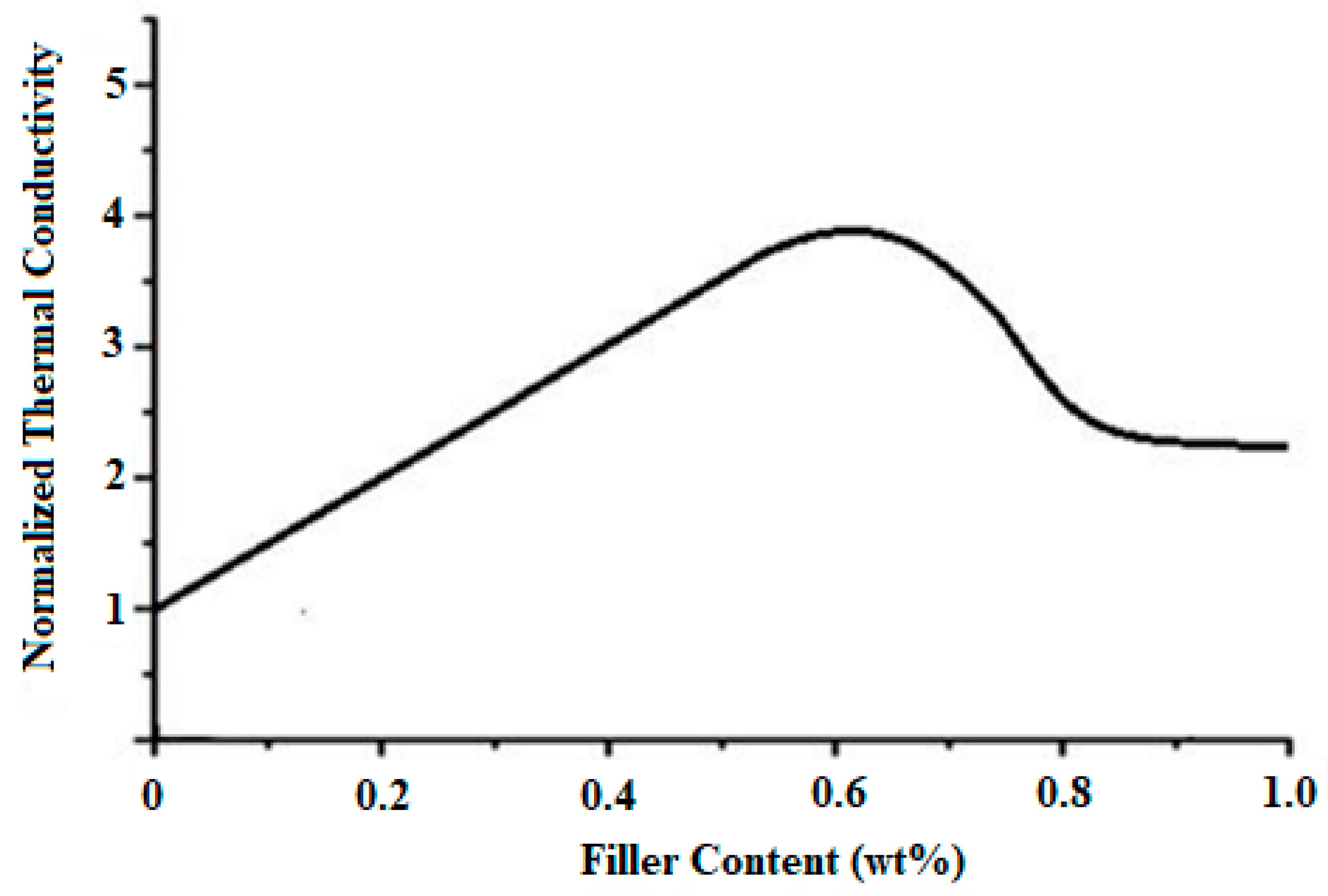
| Sample | Tensile Strength (MPa) | Young’s Modulus (MPa) | Elongation at Break |
|---|---|---|---|
| PMMA | 46.5 ± 0.01 | 5.11 ± 0.02 | 9.1 ± 0.01 |
| 0.2% VGO/PMMA Nanocomposite film | 200 ± 0.03 | 31.74 ± 0.02 | 6.3 ± 0.03 |
| 0.8% VGO/PMMA Nanocomposite film | 550 ± 0.02 | 101.85 ± 0.01 | 5.4 ± 0.01 |
| 3% VGO/PMMA Nanocomposite film | 435 ± 0.01 | 87.00 ± 0.03 | 5.0 ± 0.02 |
Disclaimer/Publisher’s Note: The statements, opinions and data contained in all publications are solely those of the individual author(s) and contributor(s) and not of MDPI and/or the editor(s). MDPI and/or the editor(s) disclaim responsibility for any injury to people or property resulting from any ideas, methods, instructions or products referred to in the content. |
© 2023 by the authors. Licensee MDPI, Basel, Switzerland. This article is an open access article distributed under the terms and conditions of the Creative Commons Attribution (CC BY) license (https://creativecommons.org/licenses/by/4.0/).
Share and Cite
Fazil, S.; Liaqat, K.; Rehman, W.; Abdellatif, M.H. Synthesis and Characterization of Electrical and Thermal Conductive Vinyltriethoxysilane Functionalized Graphene Oxide/Poly (Methyl Methacrylate) Nanocomposite Films. Membranes 2023, 13, 609. https://doi.org/10.3390/membranes13060609
Fazil S, Liaqat K, Rehman W, Abdellatif MH. Synthesis and Characterization of Electrical and Thermal Conductive Vinyltriethoxysilane Functionalized Graphene Oxide/Poly (Methyl Methacrylate) Nanocomposite Films. Membranes. 2023; 13(6):609. https://doi.org/10.3390/membranes13060609
Chicago/Turabian StyleFazil, Srosh, Khurram Liaqat, Wajid Rehman, and Magda H. Abdellatif. 2023. "Synthesis and Characterization of Electrical and Thermal Conductive Vinyltriethoxysilane Functionalized Graphene Oxide/Poly (Methyl Methacrylate) Nanocomposite Films" Membranes 13, no. 6: 609. https://doi.org/10.3390/membranes13060609





